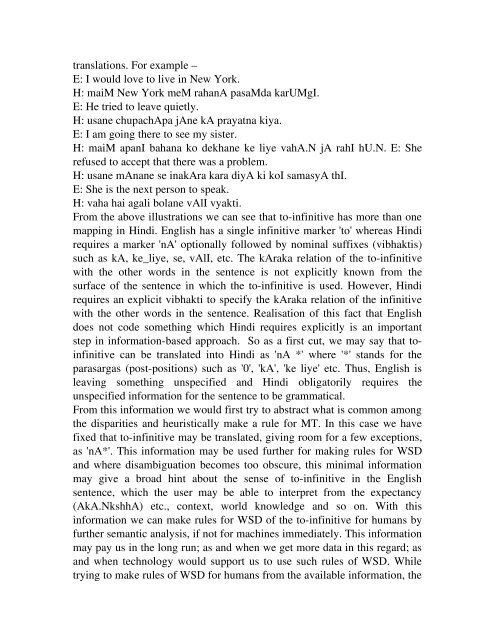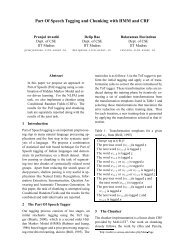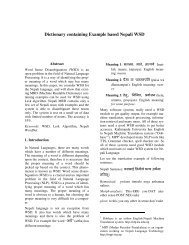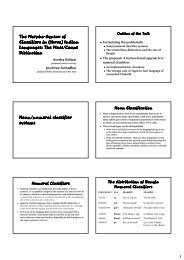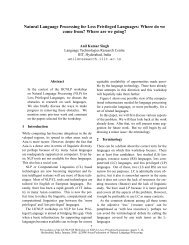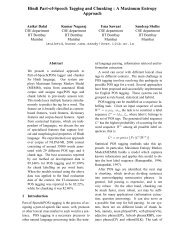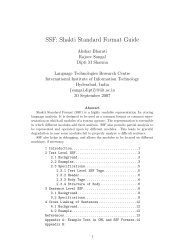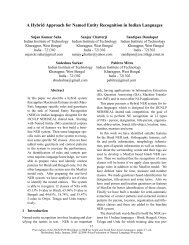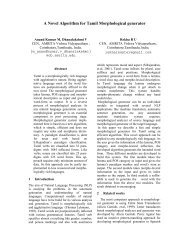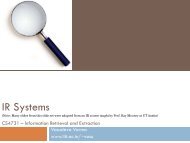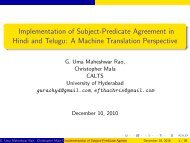WSD of ToInfinitive into Hindi : An Information Based Approach
WSD of ToInfinitive into Hindi : An Information Based Approach
WSD of ToInfinitive into Hindi : An Information Based Approach
Create successful ePaper yourself
Turn your PDF publications into a flip-book with our unique Google optimized e-Paper software.
translations. For example –<br />
E: I would love to live in New York.<br />
H: maiM New York meM rahanA pasaMda karUMgI.<br />
E: He tried to leave quietly.<br />
H: usane chupachApa j<strong>An</strong>e kA prayatna kiya.<br />
E: I am going there to see my sister.<br />
H: maiM apanI bahana ko dekhane ke liye vahA.N jA rahI hU.N. E: She<br />
refused to accept that there was a problem.<br />
H: usane m<strong>An</strong>ane se inakAra kara diyA ki koI samasyA thI.<br />
E: She is the next person to speak.<br />
H: vaha hai agali bolane vAlI vyakti.<br />
From the above illustrations we can see that toinfinitive has more than one<br />
mapping in <strong>Hindi</strong>. English has a single infinitive marker 'to' whereas <strong>Hindi</strong><br />
requires a marker 'nA' optionally followed by nominal suffixes (vibhaktis)<br />
such as kA, ke_liye, se, vAlI, etc. The kAraka relation <strong>of</strong> the toinfinitive<br />
with the other words in the sentence is not explicitly known from the<br />
surface <strong>of</strong> the sentence in which the toinfinitive is used. However, <strong>Hindi</strong><br />
requires an explicit vibhakti to specify the kAraka relation <strong>of</strong> the infinitive<br />
with the other words in the sentence. Realisation <strong>of</strong> this fact that English<br />
does not code something which <strong>Hindi</strong> requires explicitly is an important<br />
step in informationbased approach. So as a first cut, we may say that toinfinitive<br />
can be translated <strong>into</strong> <strong>Hindi</strong> as 'nA *' where '*' stands for the<br />
parasargas (postpositions) such as '0', 'kA', 'ke liye' etc. Thus, English is<br />
leaving something unspecified and <strong>Hindi</strong> obligatorily requires the<br />
unspecified information for the sentence to be grammatical.<br />
From this information we would first try to abstract what is common among<br />
the disparities and heuristically make a rule for MT. In this case we have<br />
fixed that toinfinitive may be translated, giving room for a few exceptions,<br />
as 'nA*'. This information may be used further for making rules for <strong>WSD</strong><br />
and where disambiguation becomes too obscure, this minimal information<br />
may give a broad hint about the sense <strong>of</strong> toinfinitive in the English<br />
sentence, which the user may be able to interpret from the expectancy<br />
(AkA.NkshhA) etc., context, world knowledge and so on. With this<br />
information we can make rules for <strong>WSD</strong> <strong>of</strong> the toinfinitive for humans by<br />
further semantic analysis, if not for machines immediately. This information<br />
may pay us in the long run; as and when we get more data in this regard; as<br />
and when technology would support us to use such rules <strong>of</strong> <strong>WSD</strong>. While<br />
trying to make rules <strong>of</strong> <strong>WSD</strong> for humans from the available information, the


